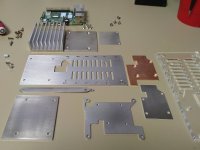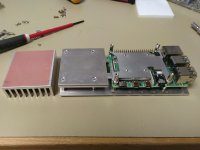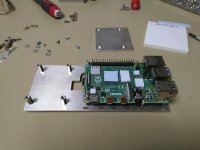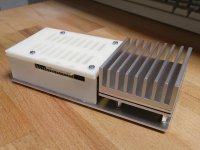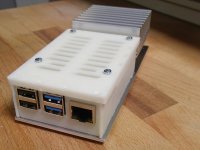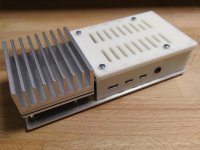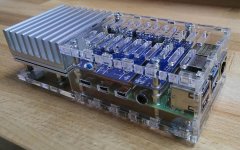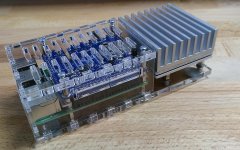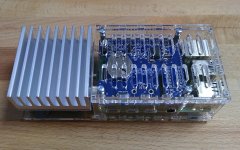... designed some metal parts for a completely passive cooling for a raspberry pi4 which allows to stack hats ...
Tested with all 4 CPUs at 100% 1.5GHz it keeps the cpu temperature below the critical 80 degree where the cpu starts throttling.
Have fun, Toni
Tested with all 4 CPUs at 100% 1.5GHz it keeps the cpu temperature below the critical 80 degree where the cpu starts throttling.
Have fun, Toni
Attachments
Last edited:
HOLY MOLY
I bought a geekworm p165 model and ran full load testing. kept it well in spec. even removed the fan.
$13 i think
I bought a geekworm p165 model and ran full load testing. kept it well in spec. even removed the fan.
$13 i think
some more pictures....
The 13$ parts are unusable for my needs.
The 13$ parts are unusable for my needs.
Attachments
That's a nice project. The Pi 4 can really use some cooling, and passive means no noise. The bottleneck of your heatpipe is the small and relatively thin strip between the Pi and and heatsink. I would be curious what kind of temp rise you will get under a sustained heavy load, since initially all the metal has to heat up and that might take 1 hour. After that its the heat flow thru the little connecting strip that is drawing heat away to the sink. What were the conditions you tested it under and for how long?
I get it that the SOC for the Pi 4 has to generate heat because the performance has gone up. The only issue that I have had all along is that they could have made things much simpler if they just moved the SOC to the bottom of the PC. Then everything can sit on a heatsink directly. For an example of a single board computer following that concept, see the Odroid N2.
The Pi 4 has an onboard WiFi slot antenna. I imagine all of this metal will hinder its performance. Too bad, because the onboard WiFi works pretty well.
I get it that the SOC for the Pi 4 has to generate heat because the performance has gone up. The only issue that I have had all along is that they could have made things much simpler if they just moved the SOC to the bottom of the PC. Then everything can sit on a heatsink directly. For an example of a single board computer following that concept, see the Odroid N2.
The Pi 4 has an onboard WiFi slot antenna. I imagine all of this metal will hinder its performance. Too bad, because the onboard WiFi works pretty well.
Last edited:
Dear Charlie,
the small stripe between heat sink and raspberry is a heatpipe capable to transport up to 18W with 0.27 ~ 0.5 °C/W @70 °C
Running aarch64 linux kernel and all 4 cpus @100% load 1.5GHz the chip die temperature stays around 60 to 62 °C at a room temperature of ~ 24°C
Left thermal picture: case closed. Right thermal picture: case opened.
There are 2 different base mounting boards:
Attached the datasheets for used heatpipe, softtherm and thermal pads. (found at conrad electronic)
Have fun, Toni
the small stripe between heat sink and raspberry is a heatpipe capable to transport up to 18W with 0.27 ~ 0.5 °C/W @70 °C
Running aarch64 linux kernel and all 4 cpus @100% load 1.5GHz the chip die temperature stays around 60 to 62 °C at a room temperature of ~ 24°C
Left thermal picture: case closed. Right thermal picture: case opened.
There are 2 different base mounting boards:
- aluminium
- acryl - you can see it on the first picture on the right side ...
Attached the datasheets for used heatpipe, softtherm and thermal pads. (found at conrad electronic)
Have fun, Toni
Attachments
-
557177-da-01-de-HEATPIPE_QG_SHP_H1_00_B9_05_100MN-1.pdf154.3 KB · Views: 162
-
189045-da-01-de-SOFTTHERM_86_300_100X100X2_MM.pdf43.3 KB · Views: 155
-
001344055-da-01-de-WAERMELEITPAD_145X145X0_5_MM.pdf624.2 KB · Views: 131
-
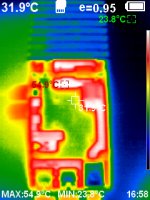 20191221-165820.jpg120.8 KB · Views: 284
20191221-165820.jpg120.8 KB · Views: 284 -
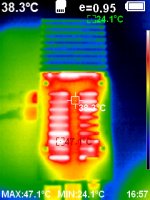 20191221-165705.jpg115.4 KB · Views: 396
20191221-165705.jpg115.4 KB · Views: 396 -
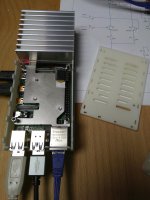 IMG_20191221_165924.jpg199.6 KB · Views: 302
IMG_20191221_165924.jpg199.6 KB · Views: 302
Last edited:
That sounds great and this is a nice design, but my question was more about how long you performed the "high load" test. How long was it?
The reason I ask is that I have seen people use a 10-15 minute run of some high-demand CPU task and a passive heat sink. The problem was that the system never reached equilbrium, meaning that the heatsink metal itself was "soaking" up the heat. Remember you are only measuring the CPU temperature, right? At some point the heatsink will heat up enough for convection into air to be the dominant heat-removal transport. But first there is a period where just heating up the heatsinnk itself is removing heat from the SOC. Since you have quite a bit of metal there, this will likely take 1 hour or more before the heat being transferred into the metal is being balanced by the heat being removed by conduction to air.
So again my question is, how long did you run the CPU stress test. Also, did you happen to monitor the temp of the heat sink, e.g. with a non-contact (laser) thermometer?
The reason I ask is that I have seen people use a 10-15 minute run of some high-demand CPU task and a passive heat sink. The problem was that the system never reached equilbrium, meaning that the heatsink metal itself was "soaking" up the heat. Remember you are only measuring the CPU temperature, right? At some point the heatsink will heat up enough for convection into air to be the dominant heat-removal transport. But first there is a period where just heating up the heatsinnk itself is removing heat from the SOC. Since you have quite a bit of metal there, this will likely take 1 hour or more before the heat being transferred into the metal is being balanced by the heat being removed by conduction to air.
So again my question is, how long did you run the CPU stress test. Also, did you happen to monitor the temp of the heat sink, e.g. with a non-contact (laser) thermometer?
That sounds great and this is a nice design, but my question was more about how long you performed the "high load" test. How long was it?
...
Test is running continuously since many hours with all 4 CPUs at 100% - no forced air convection anywhere ...
The soc and gpu temp is monitored. All other chips are also attached to the heatsink using softtherm pads.
BR, Toni
Thanks, that's a lot clearer to me now and you definitely have reached steady state. Nice work!
Just curious, what metal did you use for the heatpipe? Aluminum? Copper?
Just curious, what metal did you use for the heatpipe? Aluminum? Copper?
- The heatpipe itself is nickel plated copper (see datasheet above).
- The heatspreader above the cpu is copper where mostly all other chips can be attached using softtherm. Stainless Steel is used to mount the parts on the mainboard.
- The heatsink parts are aluminium.
Is this a prototype product? It looks like one that would sell. If not, I would be happy to buy a set of drawings and specifications.
Good Stuff!
Good Stuff!
It's a prototype to fulfill my needs for e.g.:
The white 3D printed parts are to be replaced by acryl lasered parts (hopefully coming soon).
Have fun, Toni
- rpi4 as sound server using pcm5122 based hat
- some rpi4 as aarch64 build servers for my own arm64 linux distribution
- ...
The white 3D printed parts are to be replaced by acryl lasered parts (hopefully coming soon).
Have fun, Toni
Attachments
Nice. I have one of those heatsink cases. Also passive, but obviously a lot less metal, and while GPIO is accessible, I find a GPIO extension cable does not fit in the gap in the heatsink.
I have my RPI4/4Gb overclocked to 2.175GHz. It runs very stable and not that much hotter actually. And it feels a lot quicker. Might be interesting for your servers to try.
I had it run without a heatsink for a while as well, it actually worked fine. It just slows down to keep cool. So does my RPI3. I think that most people that put sensor hats on etc. run Raspbian lite and just record some data into a file. They won't notice it throttling. Power users that overclock etc will mostly not use those hats and enjoy mounting heatsinks and fans etc.
I have my RPI4/4Gb overclocked to 2.175GHz. It runs very stable and not that much hotter actually. And it feels a lot quicker. Might be interesting for your servers to try.
I had it run without a heatsink for a while as well, it actually worked fine. It just slows down to keep cool. So does my RPI3. I think that most people that put sensor hats on etc. run Raspbian lite and just record some data into a file. They won't notice it throttling. Power users that overclock etc will mostly not use those hats and enjoy mounting heatsinks and fans etc.
This passive cooled design allows to stack RPI hats without any cap.
camera an lcd cable is still accessible... 🙂
Not only the CPU is attached to the heatspreader - all other chip are also cooled.
I have designed a hat with a battery backuped RTC (mcp7940n) and an usb console using the mcp2221a as well as a power on/off button option which safely shuts down the pi4 and allows to startup again... Here it is mounted as debug board with long header wires.
Have fun, Toni
camera an lcd cable is still accessible... 🙂
Not only the CPU is attached to the heatspreader - all other chip are also cooled.
I have designed a hat with a battery backuped RTC (mcp7940n) and an usb console using the mcp2221a as well as a power on/off button option which safely shuts down the pi4 and allows to startup again... Here it is mounted as debug board with long header wires.
Have fun, Toni
Attachments
Hmmh.
Does the heatpipe and the external sink has any impact at all?
To me it looks like the heat spreader on top of the CPU does most of the job already.
The heat would stay in the area right underneath the HAT.
And under load you still hit the 80°C as it seems. That doesn't look like a top
cooling performance to me. The solutions that I'd have in mind work nicely in the fifties.
The basic idea, attaching a "heatpipe" to the CPU, is nice of course.
HINT TO ALL:
Make sure you have the latest RPI4 eeprom firmware installed. That'll gain you
a couple of degrees without fiddling around with heatsinks.
Not sure if ArchLinux offers packages for that. Last time I looked they didn't . I had to write my own script.
Does the heatpipe and the external sink has any impact at all?
To me it looks like the heat spreader on top of the CPU does most of the job already.
The heat would stay in the area right underneath the HAT.
And under load you still hit the 80°C as it seems. That doesn't look like a top
cooling performance to me. The solutions that I'd have in mind work nicely in the fifties.
The basic idea, attaching a "heatpipe" to the CPU, is nice of course.
HINT TO ALL:
Make sure you have the latest RPI4 eeprom firmware installed. That'll gain you
a couple of degrees without fiddling around with heatsinks.
Not sure if ArchLinux offers packages for that. Last time I looked they didn't . I had to write my own script.
Carefully read post #5!
Using only the heatspreader a longer 100% cpu run is impossible. Using this heatpipe construction the cpu die temperature stays well below 60 degree celsius! Nowhere I have said this construction reaches 80 degree!
Using only the heatspreader a longer 100% cpu run is impossible. Using this heatpipe construction the cpu die temperature stays well below 60 degree celsius! Nowhere I have said this construction reaches 80 degree!
- Home
- Source & Line
- PC Based
- raspberry pi4 passive cooler - heatpipe based
